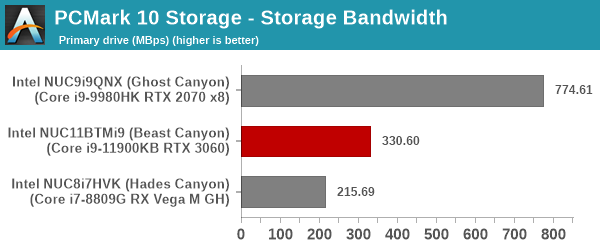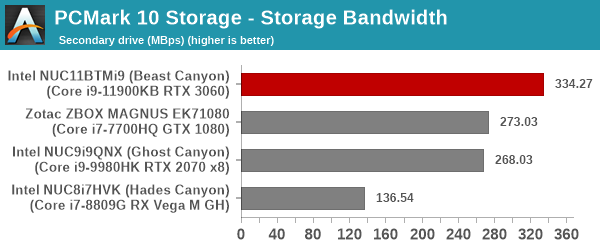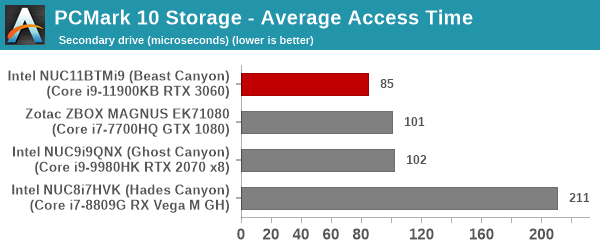Intel Beast Canyon NUC Review: Desktop Tiger Lake Debuts in SFF Gaming Powerhouse
by Ganesh T S on July 29, 2021 9:00 AM EST- Posted in
- Systems
- Intel
- NUC
- Tiger Lake
- NUC11
- Beast Canyon
Miscellaneous Aspects and Concluding Remarks
The storage subsystem in the Tiger Lake-based notebooks and PCs presents some interesting aspects. These are the first crop of SFF / battery-powered devices to sport direct CPU-attached PCIe Gen 4 capabilities. The PCMark 10 suite includes a storage benchmark suite. The Sabrent Rocket NVMe 4.0 (directly attached to the CPU) was subject to the 'Full System Drive Benchmark'. Note that there are two sets of graphs below, as we configure a primary and a secondary drive / partition for all evaluated systems. In the case of the Ghost Canyon NUC, the Optane drive was fully allocated as the primary partition. For the Beast Canyon NUC, the drive was partitioned into two - a 180GB OS partition, and a 285GB data partition.




Despite the PCIe 3.0 link, the direct-attached Optane drive in the Ghost Canyon is the top performer by a significant margin in terms of both bandwidth and average access time for real-world applications. In the secondary drive shootout between NAND flash-based SSDs, the PCIe 4.0 link helps the Sabrent Rocket NVMe 4.0 emerge as the leader.
The Beast Canyon NUC brings two important updates on the networking front. The Wi-Fi 6E capability enabled by the Intel AX210 allows wireless access over the 6GHz spectrum that is not subject to as much interference as the 5GHz and 2.4GHz ones. The wired side also receives a boost with 2.5G BASE-T support. The dual LAN capability present in the Ghost Canyon NUC has unfortunately been done away with. That said, the presence of Thunderbolt 4 ports with hub capabilities offers a lot of flexibility to end users. There are many Thunderbolt 4 docks and hubs in the market with such added features.
One of the aspects usually covered in detail in our SFF PC reviews relates to the usage of the system as a HTPC. Being a full-blow gaming desktop, it is unlikely for the Beast Canyon NUC to be used solely as a home-theater PC. The system manages to play back 4K content in multiple different codecs, and YouTube / Netflix UHD content play flawless without dropped frames. However, its noise profile and power consumption numbers do not make it effective or efficient for such tasks. We do plan to evaluate the HTPC capabilities of the Tiger Lake platform in a future piece (with one of the low-power NUCs). That said, if there is enough reader interest, we can do a similar analysis for the Ampere GPU in SFF systems such as the Beast Canyon NUC.
Closing Thoughts
Coming to the business end of the review, Intel's Beast Canyon NUC (NUC11BTMi9) is the latest and greatest performance-oriented mini-PC. The gaming market has been one of the primary drivers of growth in the PC space, and it is no surprise that the Beast Canyon NUC has its sights locked on to that segment. It is a worthy follow-up to last year's Ghost Canyon NUC. In particular, by putting in enough room for a 350W PCIe video card up to 12 inches in length while still retaining a small form factor, Intel has resolved a major issue that had prevented the NUCs from capturing a share of the gaming market. And the inclusion of features such as user-addressable RGB lighting (opinions may be divided on this, but RGB undoubtedly sells) make it all the more attractive for the gaming crowd.
Intel is not alone in trying to make SFF gaming systems attractive to consumers. OEMs like Zotac have been playing in this market for a few years now. The ZBOX E-series MAGNUS line of mini-PCs have slowly moved forward from MXM-type GPUs to full-blown discrete ones. The MAGNUS ONE announced at the 2021 CES has been shipping for a few months now. That system took cues from the Ghost Canyon NUC, but tweaked things enough to be able to accommodate a proper socketed Comet Lake desktop CPU. It doesn't come with premium features such as Thunderbolt 4 or 2.5G BASE-T support.
To that end, Intel would do well to adopt some of the aspects of the MAGNUS ONE such as a Type-C port in the front panel, avoiding of recessed ports, and a rear panel tuned for good cable management. The MAGNUS ONE also allows for tool-less disassembly to access the internals. The Ghost Canyon and Beast Canyon chassis designs are overly complicated when compared to Zotac's.

From L to R: Beast Canyon, Ghost Canyon, Zotac ZBOX MAGNUS ONE
The default BIOS configuration used for evaluating the Beast Canyon put it in the maximum performance mode. The PL1 and PL2 values were set for 65W and 109W. In terms of load and idle power consumption, there is not much to differentiate between the Ghost Canyon NUC and the Beast Canyon NUC. However, the benchmark numbers show a clear advantage for the Tiger Lake-enabled Beast Canyon. The BIOS could do with some tweaks to alter the fan curves for better thermals, while also trying to minimize the noise profile.
Overall, the 65W TDP Compute Element is a winner in terms of providing an ideal platform for a SFF gaming desktop that is powerful, yet power-efficient. The Monster Cove baseboard, though, leaves a bit on the table. The change in the location of the non-M.2 PCIe x4 slot and the need to use an air guide for the Compute Element may cause issues in certain use-cases that require and utilize a x8/x4/x4 PCIe bifurcation configuration. Moving the M.2 22110 slot to the underside is worth appreciating, though.
As for the Beast Canyon chassis, the build and appearance are suitable for the target market. Compared to other designs, third-party cases for the Driver Bay Compute Elements such as Akasa's Cypher HDB adopt different tradeoffs in terms of size, shape, and weight. They can cater to niches where the Beast Canyon chassis might not be entirely suitable or preferable.
Overall, Intel has been slowly building up a robust ecosystem around the Compute Elements, and with the focus on the gaming market, they should be able to reach economies of scale easily to drive their vision further. One of the complaints about the Ghost Canyon NUC was the pricing aspect. The NUC9i9QNX launched in July 2020 at $1700. The NUC11BTMi9 carries a much more palatable $1350 price tag. The NUC11BTMi7 is expected to be priced at $1150. The Compute Elements themselves are in the $780 - $980 price bracket. Availability of the Tiger Lake NUCs has been a major concern this year. Intel expects the Beast Canyon NUCs to start selling this quarter with broader availability during the holiday season.











84 Comments
View All Comments
Spunjji - Friday, July 30, 2021 - link
"Can I buy the new compute element card and put it in a Ghost Canyon case?"I've been wondering that - I thought part of the point of the Element was to enable that sort of upgrade, but then I guess you'd lose the PCIe 4.0 compatibility
damianrobertjones - Friday, July 30, 2021 - link
Question: Can you purchase (I believe you can) JUST the element and place it into the previous model's chassis? That's what I was led to believe with this 'supposed' upgradability. If not, then possibly avoid this machine as there won't (probably) be an upgrade path. I did own the previous gen.Question 2: What the heck is going on with the smaller Nuc 11 units? I cannot seem to buy one ANYWHERE (u.k.).
mode_13h - Monday, August 2, 2021 - link
I think Tiger Lake is simply in high-demand. Intel likely prioritizes notebook OEMs above its own NUCs. Most NUC buyers probably don't know or care about the difference between 10th gen and 11th gen, so it's less bad to undersupply that market. Of course, this is all speculation.vol.2 - Tuesday, August 3, 2021 - link
I'm assuming they use the cheapest fans they can get away with. I'm sure the noise would improve dramatically if you replaced them with some better ones.Oxford Guy - Wednesday, August 11, 2021 - link
I’m sure the laws of physics are malleable.JoeDuarte - Tuesday, August 3, 2021 - link
1. It would help to benchmark them with more realistic specs, and consistent specs across the different SFF computers you included. 16 GB of RAM is too little for something this high-end, with an 8-core i9 Tiger Lake CPU, and a new-gen Nvidia 3060 GPU. (And you had 32 GB of in the Zotac...) 512 GB of SSD is too small for this kind of build, and there are big differences in SSD performance between 512 GB units and 1 TB+ sizes. (And you have different SSD models and sizes across the tested computers, ruining the validity of the results.)2. Intel's prices are still a bummer. I love the idea of a NUC, and of these X Canyon big-NUCs, but their prices and availability have always ruled them out. It's just worth it for what you get. We have to add several hundred dollars to that $1,350 price for this model. And hundreds more for a display, keyboard, and mouse. It's easily a $2,000 build, probably more like $2,300, all before taxes.
It makes more sense to go to PCPartPicker and build out a compact PC using one of those cuboid cases. They're a lot bigger than NUCs, but much smaller than mid-towers.
3. Intel really struggles with naming and model numbers. The NUCs are a messy jumble of letters and digits. And Intel commits the sin of having multiple names for the same thing, and you have to keep track of numerous confusing terms and their relation to each other. e.g.:
-- Goldmont vs. Apollo Lake, using Skylake arch, vs. Braxton vs. Willow Trail
-- Cherryview vs. Cherry Trail vs. Airmont
-- Beast Canyon vs. Bean Canyon vs. NUC vs. NUC11BTMi9
-- NUC11BTMi9 vs NUC11DBBi9, where the former is supposed to be a computer and the latter is a "Compute Element"
Nothing about the substring BTMi9 screams "computer", and nothing about the substring DBBi9 screams "Compute Element". It's all such a mess, and it makes it hard to shop for and buy Intel's products. If you don't already know the exact model number of what you want, there's no way to know from the model numbers that you encounter what you're getting or where it fits into the larger context of NUC models. These are things that any organization should be able to fix – clean, consistent naming, and clean, concise, and non-ugly model numbers.
mode_13h - Wednesday, August 4, 2021 - link
> It makes more sense to go to PCPartPicker and> build out a compact PC using one of those cuboid cases.
Except you cannot buy a Tiger Lake-H CPU. They're only sold in BGA and mostly found in laptops.
Unlike the Gemini/Jasper/Elkhart Lake CPUs (which are also BGA and often found in Chromebooks), you probably can't buy a mITX motherboard with them pre-installed, either.
JoeDuarte - Thursday, August 12, 2021 - link
I didn't think of that, though it wouldn't matter in my case. Whenever I build out a system at PCPartPicker I choose the Core i7-11700 or one of the Zen 3 chips – I think it's called a 5600 or 5800, but I forget. I don't think Tiger Lake-H would be an improvement from those, just maybe lower power.The GPUs are decent for integrated, and that has made me lean toward Intel because of the difficulty in finding current gen discrete GPUs like the 3060 Ti, but I haven't pulled the trigger yet. The Zen 3s don't have integrated GPUs, which would leave me without a GPU unless I settled for an obsolete 1650 or something. I'd rather live with the Intel 750 for a spell until the powerhouses are available at normal prices.
mode_13h - Friday, August 13, 2021 - link
> I choose the Core i7-11700 ... I don't think Tiger Lake-H would be an improvement> from those, just maybe lower power.
There are some notable differences. The desktop 11th gen CPUs are Rocket Lake, built on Intel's 14 nm++++ process, using Cypress Cove cores. Those cores are a 14 nm back-port of Ice Lake's (launched in 2019) Sunny Cove.
The Laptop & NUC 11th gen CPUs are Tiger Lake, which use Intel's 10 nm+++ node (also called 10 nm SF). They use Willow Cove cores, which are a generation newer than Ice Lake's (and therefore Rocket Lake's). However, the generational gains of the cores were modest, with the main difference being that Tiger Lake clocks higher.
Now, if you want to compare spec-for-spec, try this:
https://ark.intel.com/content/www/us/en/ark/compar...
The main thing that shows is that Tiger Lake-H has 50% more cache and the top-end model clocks lower. However, being a laptop chip, the top-end model also has a TDP of just 65 W. So, it's probably better to compare it with the fastest 65 W Rocket Lake:
https://ark.intel.com/content/www/us/en/ark/compar...
According to that, Tiger Lake-H is able to offer a much better Base clock, though its turbo is still lower. That's probably because its peak power is also lower, again being a laptop chip. Furthermore, clock speeds don't tell the whole story. In the end, specs are no match for actual benchmarks:
https://www.tomshardware.com/news/intels-enthusias...
These benchmarks show Rocket Lake pulling ahead in GPU tests, probably due to its faster turbo. However, when it comes to CPU-intensive tests, we see Tiger Lake hold its own.
Unfortunately, not many people seem to have run that exact comparison. Most are either comparing with the top Rocket Lake SKU or just other SFF PCs. If anyone else has benchmarks of the i9-11900KB vs. i9-11900, please share.
I guess the point is that if you care about power/noise/size, this NUC Extreme seems pretty compelling. If you're willing to spend a bit more and go for a top-of-the-line desktop, then you should probably fare better with Rocket Lake.
I wish Tiger Lake-H came in a LGA-1200 socketed version, so we could really see it stretch its legs. I'll bet it would beat even i9-11900KF by a noticeable amount.
> The Zen 3s don't have integrated GPUs
They do now! Check out the new Ryzen 5000G models!
https://www.anandtech.com/show/16824/amd-ryzen-7-5...
They're decent, for an integrated GPU, but not on par with the RTX 3060 in this NUC Extreme.
mode_13h - Wednesday, August 4, 2021 - link
> And Intel commits the sin of having multiple names for the same thing,> and you have to keep track of numerous confusing terms and their
> relation to each other. e.g.:
>
> -- Goldmont vs. Apollo Lake, using Skylake arch, vs. Braxton vs. Willow Trail
> -- Cherryview vs. Cherry Trail vs. Airmont
Goldmont is the core. Apollo Lake is the SoC. The "Mont" cores are the low-power ones. They've been very consistent about that: Silvermont, Airmont, Goldmont, Goldmont+, Tremont, and soon Gracemont.
Starting with Ice Lake, the big cores are named after coves, so far.
And the "Trail" names seem to be system designs, or something?
The one naming convention that really got out of control is the "lakes". Those seem to have very little consistent meaning. I think they have a few Lakes that aren't even CPUs/SoCs.
> Nothing about the substring BTMi9 screams "computer"
It's just a model number, dude. Just type it into a search engine and look it up. And some places I've seen will at least say it's a NUC compute element, although that requires you to know how one differs from a regular NUC.
> It's all such a mess
I will agree that Intel's product line is full of subtle variations, like NUCs with one vs. two Ethernet ports. I was staring at two Tiger Lake NUC listings, trying to figure out the difference, until I noticed that.